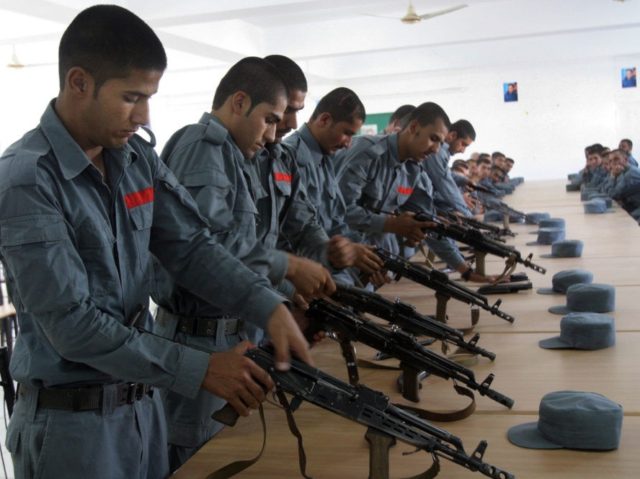Men dressed in uniforms of the U.S.-backed Afghan National Defense and Security Forces (ANDSF) have killed more Americans so far this year than the Taliban in what is known as insider or “green on blue” attacks, according to a report by the Special Inspector General for Afghanistan Reconstruction (SIGAR), a U.S. watchdog agency.
In its latest quarterly report to Congress, SIGAR notes that two U.S. service members were killed and another one wounded in three “green on blue” attacks that occurred between January 1 and mid-August, adding that another U.S. service member and an American civilian were killed in a suspected insider attack in Kabul on October 19. One U.S. service member and two American civilians were wounded that day.
If authorities confirm the October 19 incident as an insider attack, it would mean Afghan soldiers killed three of the four U.S. troops killed in combat in Afghanistan as of the end of October.
Of the four U.S. combat-related fatalities in Afghanistan so far this year, one has been linked to the Islamic State (ISIS/ISIL) branch in the country and none directly to the Taliban.
Some analysts suggests that the “green on blue” attacks are the result of Taliban infiltration of the Afghan security forces. Two of the U.S. service members killed in insider attacks this year were executed in Helmand.
SIGAR notes:
While [Afghan army] recruits surveyed in December 2015 (21%) and March 2016 (19%) reported the highest percentage of contact with anti-government elements [such as the Taliban], overall 16% of recruits reported being approached by anti-government elements. Anti-government elements are reported to watch for opportunities to influence or compromise ANA [Afghan National Army recruits].
Meanwhile, SIGAR reports that the Taliban appears to have captured more territory.
The U.S. watchdog agency conceded that the “ANDSF intentionally ceded ground” in areas where its ability to secure territory was limited, including parts of Helmand province, a southern Afghan province that borders Pakistan and has historically been a Taliban stronghold.
Helmand, the top opium-producing province in Afghanistan, is one of the deadliest regions for U.S.-led coalition troops fighting in the country. Taliban jihadists use the proceeds from the illegal sale of opium, which is used to make heroin, to fund their terrorist activities.
“The overall security situation remained highly volatile as intensive Taliban operations continued, challenging government control in northeastern, northern, and southern provinces, and attempting to cut key supply routes,” declares SIGAR.
There are 407 districts within the 34 provinces that make up Afghanistan.
Citing the U.S. Forces in Afghanistan (USFOR-A), SIGAR reveals that more than “one-third of the country’s districts are either under insurgent control [8] or influence [25], or at risk [116] of coming under it.”
That means 37 percent (149) of the Afghan districts have been deemed by the U.S. military to be under the control or influence of terrorists, primarily the Taliban, or “contested” which refers to districts that have a “negligible meaningful impact from insurgents,” notes the watchdog agency.
SIGAR learned from the U.S. military that the Afghan government controls (88) or influences (170) about 63 percent of the country’s districts, marking a decrease from the 66 percent reported as of the end of May.
The majority of insider attack victims have been ANDSF members.
“There were 101 insider attacks in which ANDSF personnel turned on fellow ANDSF security forces [since January 2015]… These attacks killed 257 Afghan personnel and wounded 125. Of these attacks, 44 occurred in 2016, killing 120 and wounding 70.”
The five “green on blue” attacks during all of 2015 killed three U.S. personnel and wounded 14.
“Insider attacks during 2015 were also responsible for the death of three of the seven U.S. civilians killed in Afghanistan and one of the nine wounded during this period,” notes SIGAR.
Although ISIS is operating in Afghanistan, the U.S.-backed Afghan government is primarily losing territory to the Taliban, the most prominent jihadist group in country, believed to be in control of more land now than at any point since the American military removed them in 2001.
SIGAR identified deteriorating security conditions as the predominant obstacle facing the social development of Afghan women.
The U.S. watchdog agency notes:
Afghanistan’s lack of security—not only makes it dangerous for women to go to school, work outside the home, and access health services, but also perpetuates social attitudes that women are vulnerable and thus should not leave the home. The second most frequently cited challenge, pervasive corruption, hinders women’s ability to compete with men in a male-dominated social environment and has allegedly led to funds intended for women’s programs being misspent.
Citing the United Nations, the SIGAR reports, “Fifteen years after the United States ousted the Taliban regime, Afghanistan remains one of the worst places in the world to be a woman.”
Women face the most difficult challenges in the territory under the control or influence of the Taliban.
“In these areas, the Taliban seek to punish women who work or study outside the home,” points out SIGAR.”A number of the women interviewed [by SIGAR] had their lives threatened or had relatives killed by the Taliban.”

COMMENTS
Please let us know if you're having issues with commenting.